Abstract
To evaluate the usefulness of an immunohistologic approach to the differential diagnosis of mesothelioma and pulmonary adenocarcinoma, the authors studied paraffin-embedded, fixed tissue sections from 50 primary adenocarcinomas of the lung and 28 mesotheliomas of the pleura by using a panel of monoclonal antikeratin, antihuman milk fat globule (HMFG-2), anti-Leu M1, and monoclonal anticarcinoembryonic antigen (CEA) antibody; we also used a conventional heterologous anti-CEA antiserum with and without prior absorption with spleen powder to remove antibodies to nonspecific cross-reacting antigen (NCA). Keratin was present in both mesotheliomas and adenocarcinomas and did not help in distinguishing between these two neoplasms. HMFG-2 was detected in 48 (96%), and Leu M1 was positive in 47 (94%) of the adenocarcinomas, but not in any of the mesotheliomas. By using conventional rabbit antiserum, the authors detected CEA in the majority of adenocarcinomas (96%), but also in two cases of mesothelioma. When the anti-CEA antiserum was absorbed with NCA, the number of positively reacting adenocarcinomas decreased considerably to 76%; however, after this treatment, none of the mesotheliomas gave positive reactions. The monoclonal anti-CEA antibody was reactive in 36 of the adenocarcinomas (72%), but in none of the mesotheliomas. Our results indicate that, in addition to HMFG-2 and CEA, the expression of Leu M1 antigen by most primary pulmonary adenocarcinoma (94%) and its absence in mesothelioma could be used as a valuable marker for primary adenocarcinoma of the lung that involves the pleura and permits its differentiation from mesothelioma.
Full text
PDF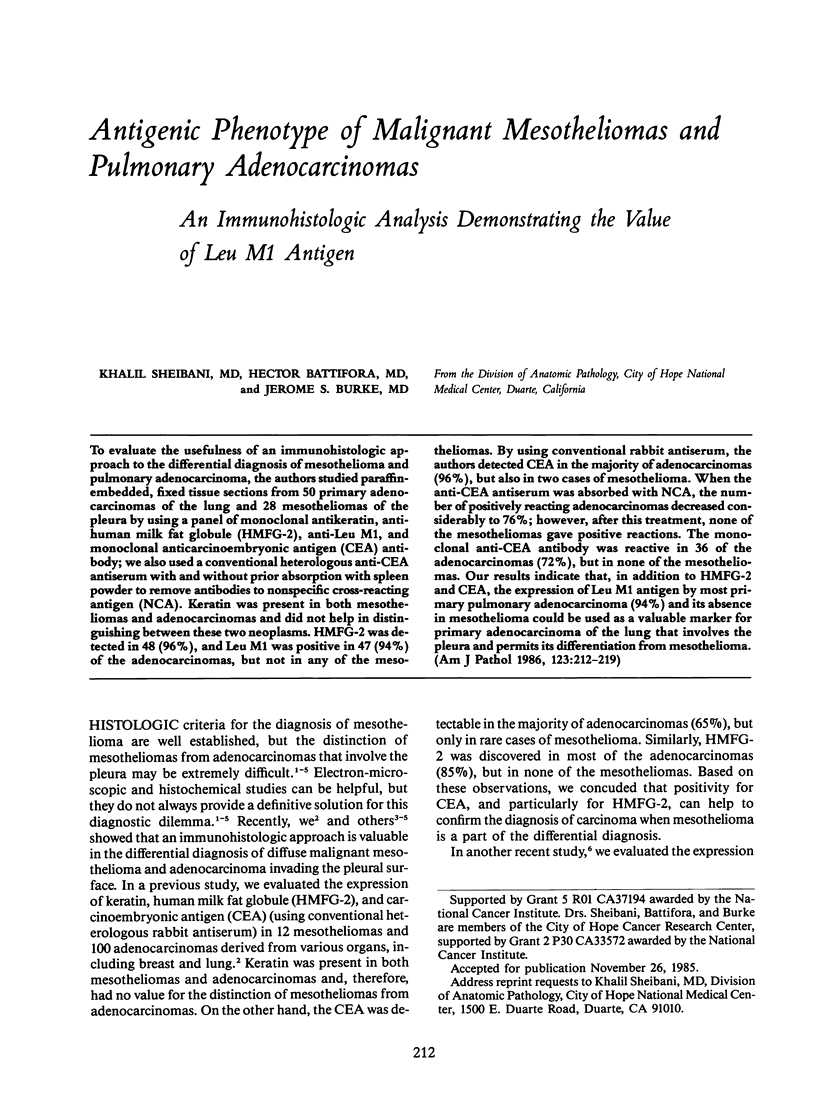
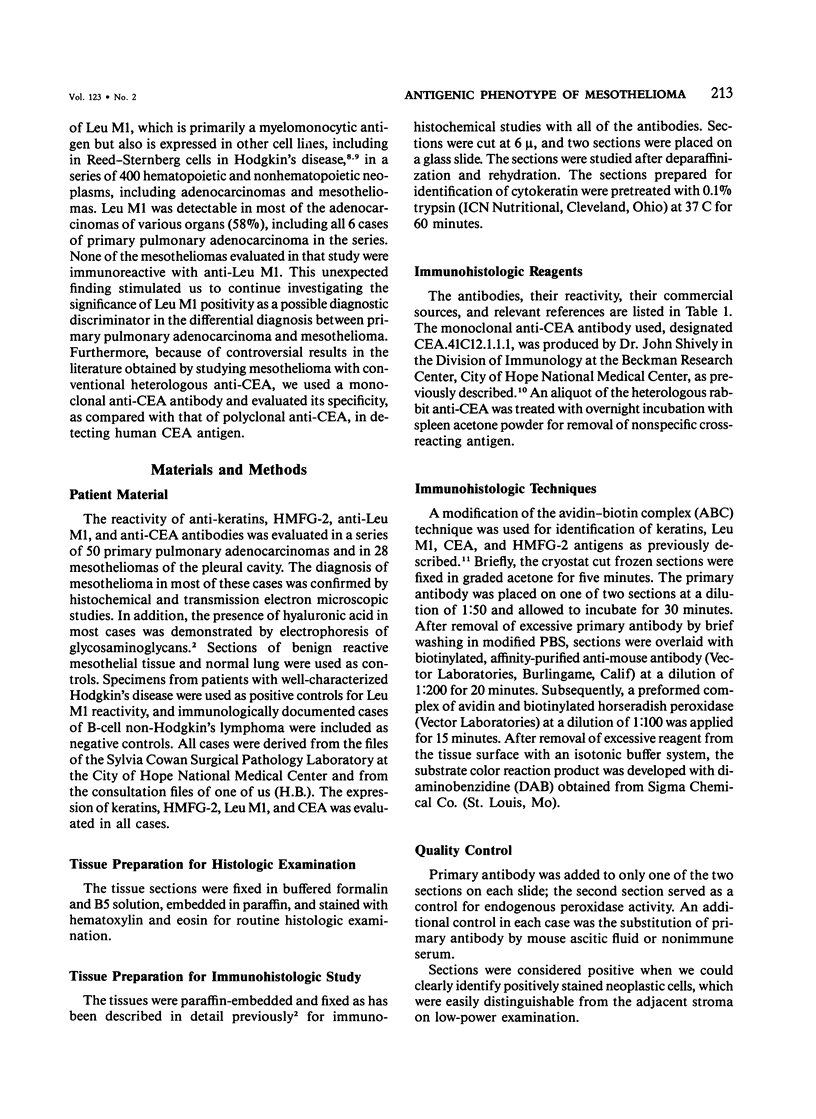
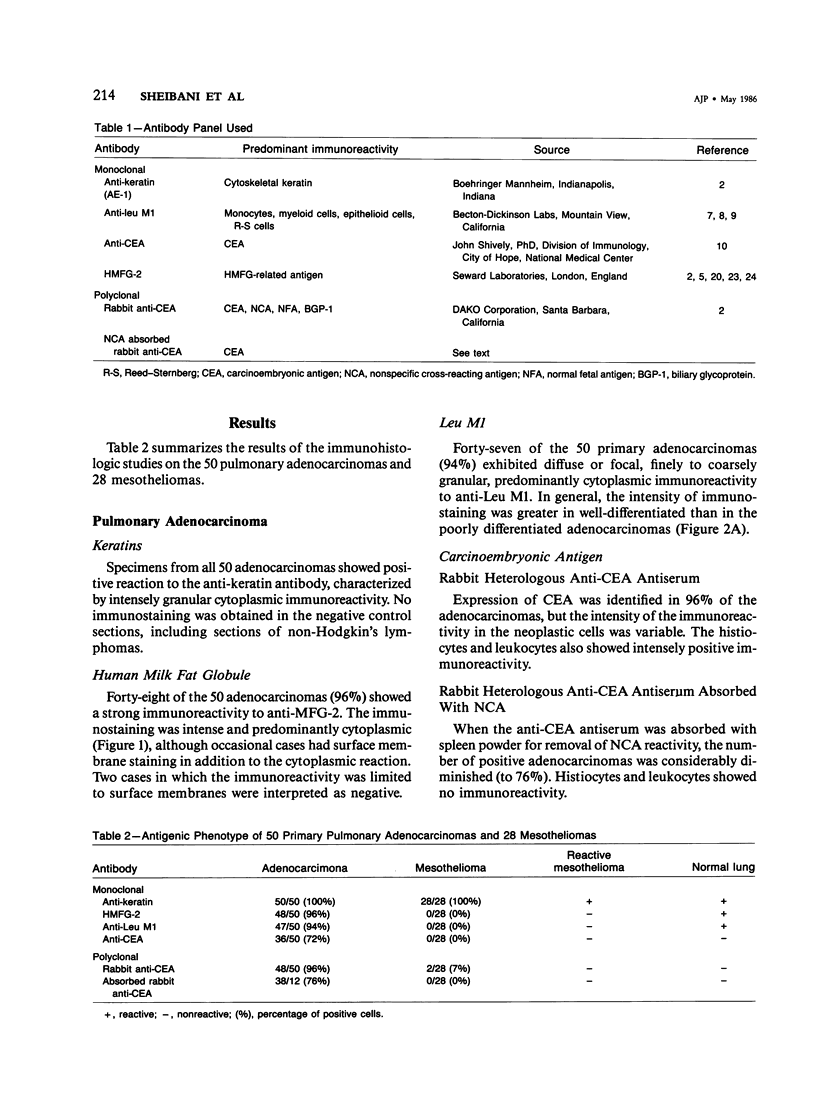
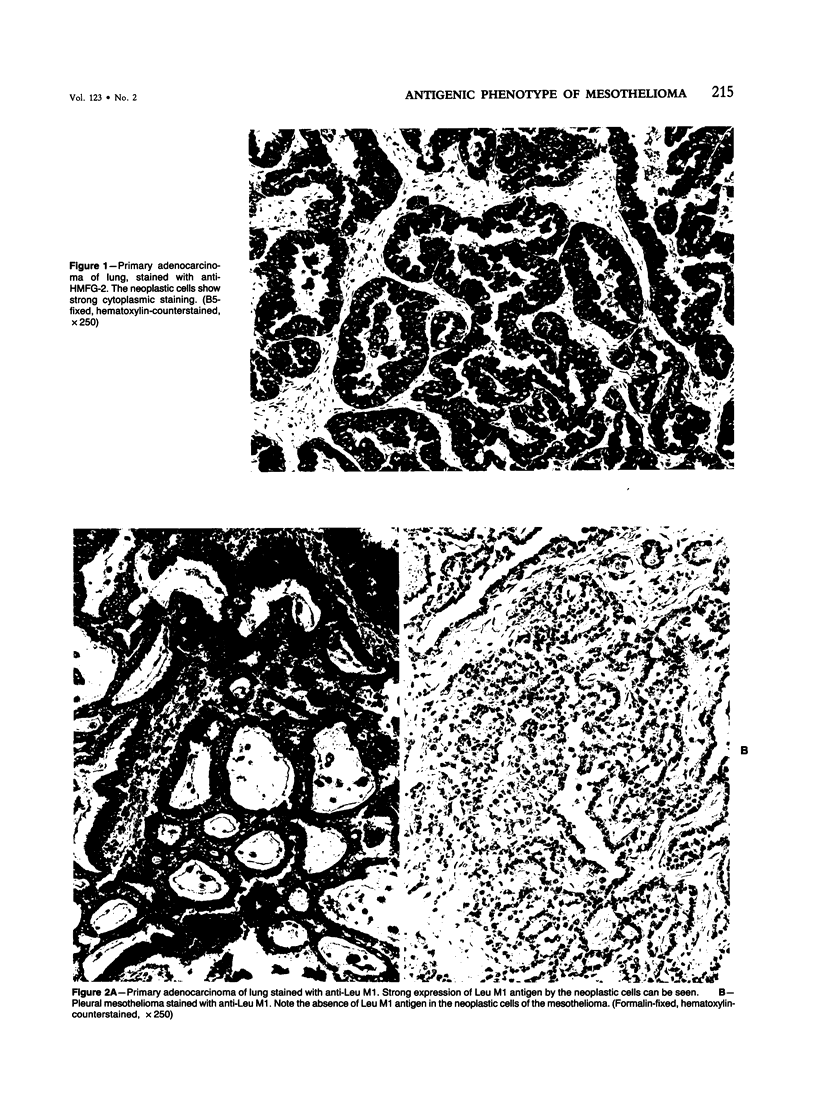
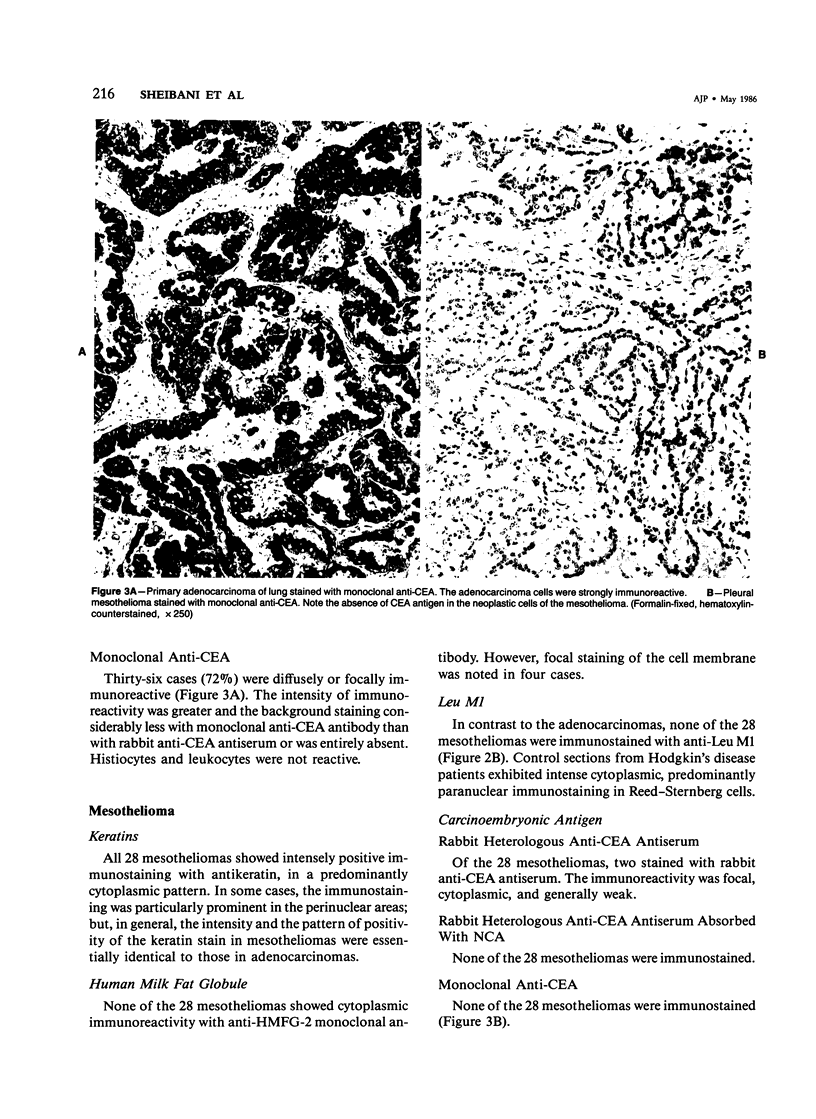
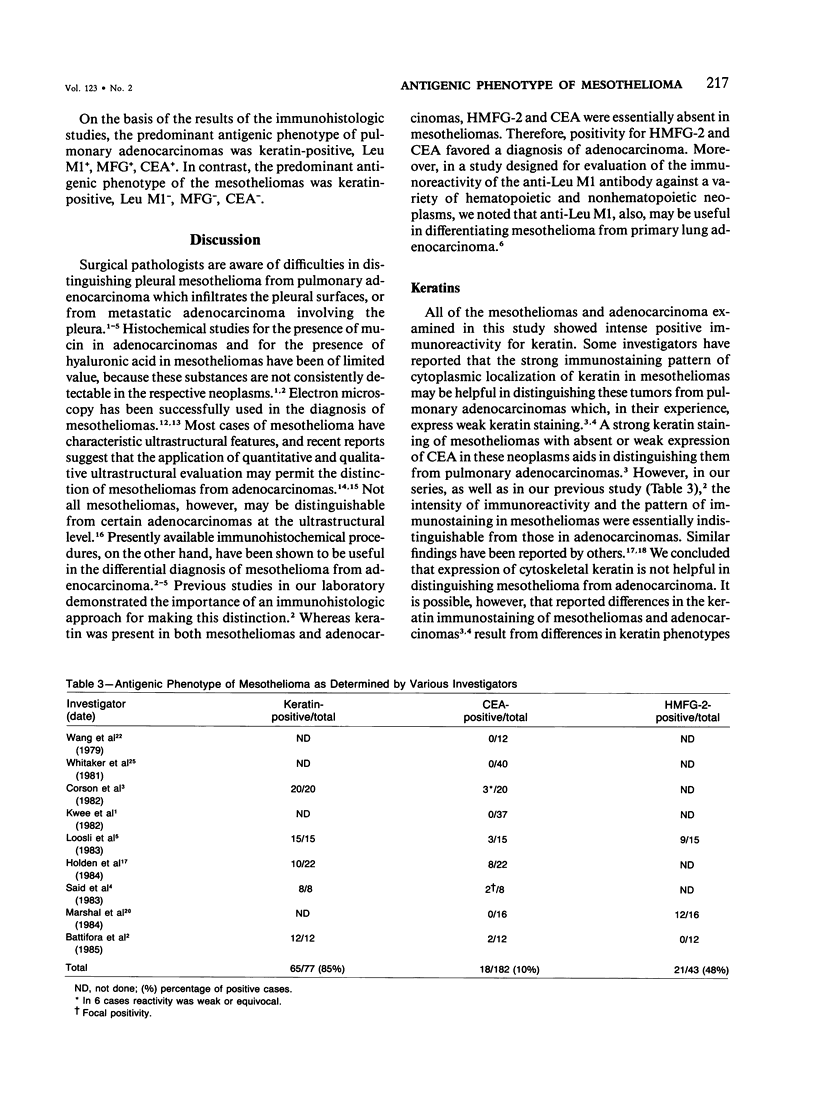
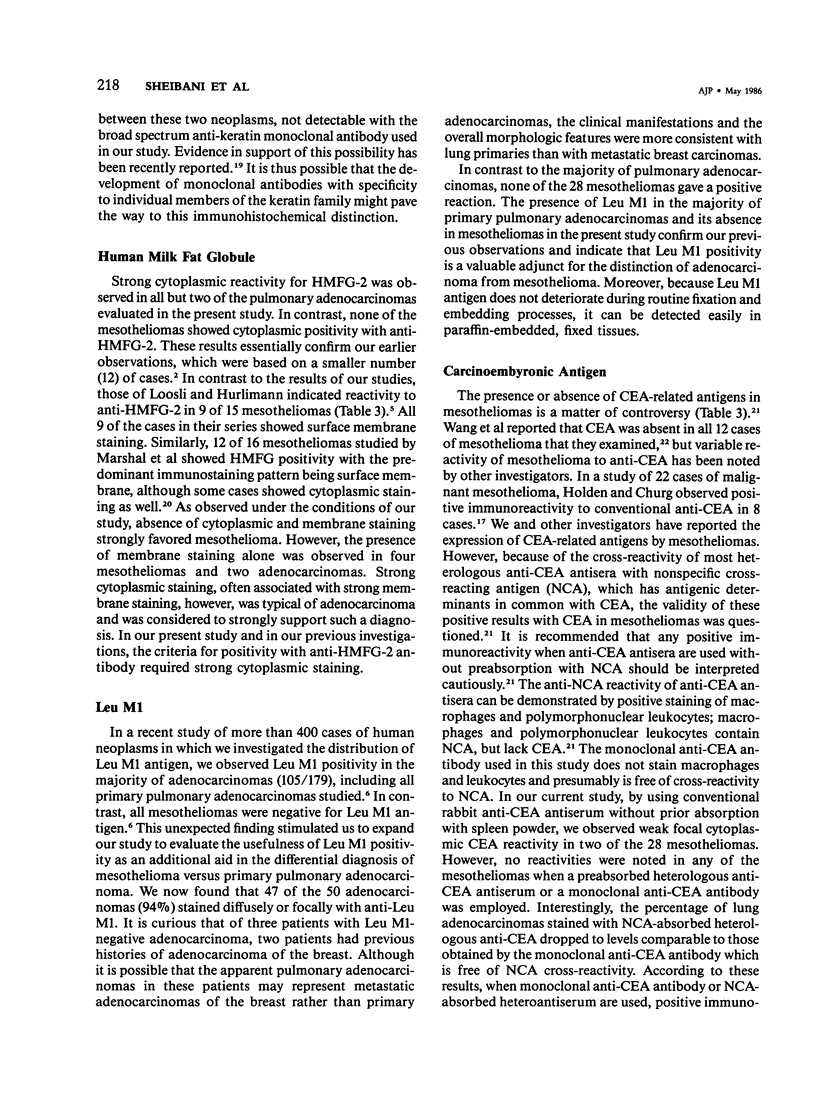
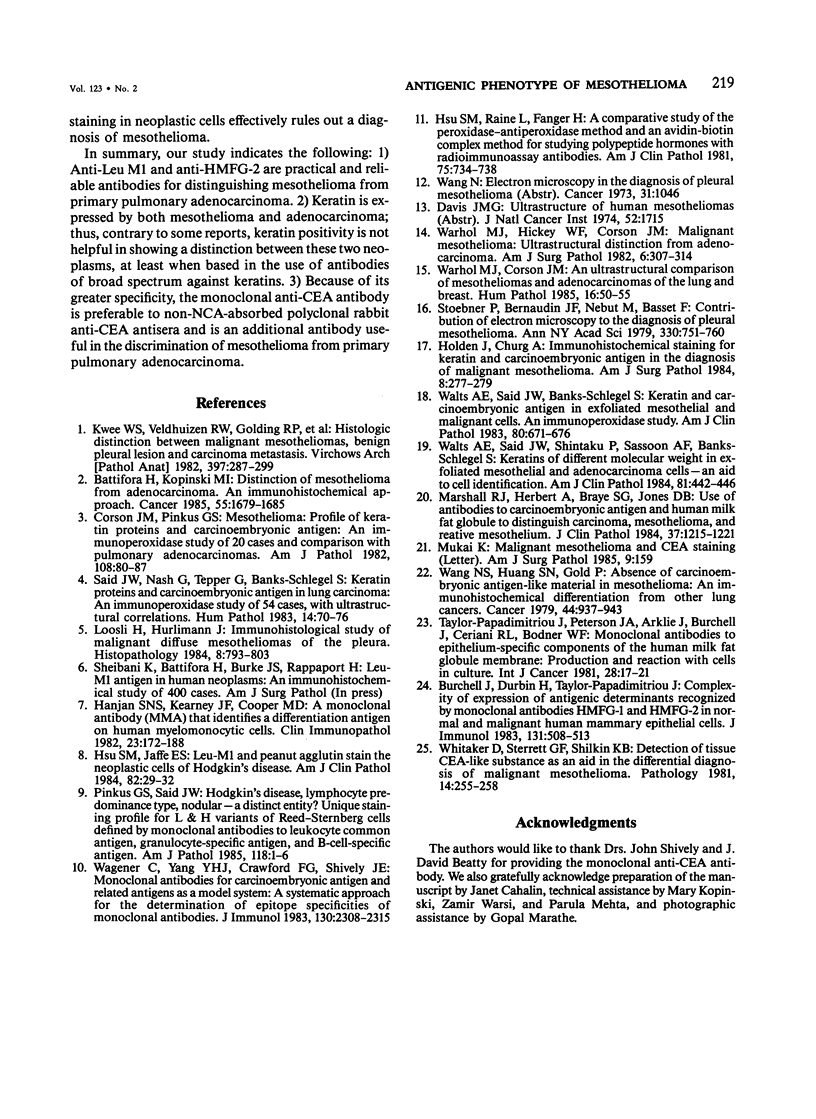
Images in this article
Selected References
These references are in PubMed. This may not be the complete list of references from this article.
- Battifora H., Kopinski M. I. Distinction of mesothelioma from adenocarcinoma. An immunohistochemical approach. Cancer. 1985 Apr 15;55(8):1679–1685. doi: 10.1002/1097-0142(19850415)55:8<1679::aid-cncr2820550812>3.0.co;2-c. [DOI] [PubMed] [Google Scholar]
- Burchell J., Durbin H., Taylor-Papadimitriou J. Complexity of expression of antigenic determinants, recognized by monoclonal antibodies HMFG-1 and HMFG-2, in normal and malignant human mammary epithelial cells. J Immunol. 1983 Jul;131(1):508–513. [PubMed] [Google Scholar]
- Corson J. M., Pinkus G. S. Mesothelioma: profile of keratin proteins and carcinoembryonic antigen: an immunoperoxidase study of 20 cases and comparison with pulmonary adenocarcinomas. Am J Pathol. 1982 Jul;108(1):80–88. [PMC free article] [PubMed] [Google Scholar]
- Davis J. M. Ultrastructure of human mesotheliomas. J Natl Cancer Inst. 1974 Jun;52(6):1715–1725. doi: 10.1093/jnci/52.6.1715. [DOI] [PubMed] [Google Scholar]
- Holden J., Churg A. Immunohistochemical staining for keratin and carcinoembryonic antigen in the diagnosis of malignant mesothelioma. Am J Surg Pathol. 1984 Apr;8(4):277–279. doi: 10.1097/00000478-198404000-00004. [DOI] [PubMed] [Google Scholar]
- Hsu S. M., Jaffe E. S. Leu M1 and peanut agglutinin stain the neoplastic cells of Hodgkin's disease. Am J Clin Pathol. 1984 Jul;82(1):29–32. doi: 10.1093/ajcp/82.1.29. [DOI] [PubMed] [Google Scholar]
- Hsu S. M., Raine L., Fanger H. A comparative study of the peroxidase-antiperoxidase method and an avidin-biotin complex method for studying polypeptide hormones with radioimmunoassay antibodies. Am J Clin Pathol. 1981 May;75(5):734–738. doi: 10.1093/ajcp/75.5.734. [DOI] [PubMed] [Google Scholar]
- Kwee W. S., Veldhuizen R. W., Golding R. P., Mullink H., Stam J., Donner R., Boon M. E. Histologic distinction between malignant mesothelioma, benign pleural lesion and carcinoma metastasis. Evaluation of the application of morphometry combined with histochemistry and immunostaining. Virchows Arch A Pathol Anat Histol. 1982;397(3):287–299. doi: 10.1007/BF00496570. [DOI] [PubMed] [Google Scholar]
- Loosli H., Hurlimann J. Immunohistological study of malignant diffuse mesotheliomas of the pleura. Histopathology. 1984 Sep;8(5):793–803. doi: 10.1111/j.1365-2559.1984.tb02395.x. [DOI] [PubMed] [Google Scholar]
- Marshall R. J., Herbert A., Braye S. G., Jones D. B. Use of antibodies to carcinoembryonic antigen and human milk fat globule to distinguish carcinoma, mesothelioma, and reactive mesothelium. J Clin Pathol. 1984 Nov;37(11):1215–1221. doi: 10.1136/jcp.37.11.1215. [DOI] [PMC free article] [PubMed] [Google Scholar]
- Mukai K. Malignant mesothelioma and CEA staining. Am J Surg Pathol. 1985 Feb;9(2):159–160. doi: 10.1097/00000478-198502000-00015. [DOI] [PubMed] [Google Scholar]
- Pinkus G. S., Said J. W. Hodgkin's disease, lymphocyte predominance type, nodular--a distinct entity? Unique staining profile for L&H variants of Reed-Sternberg cells defined by monoclonal antibodies to leukocyte common antigen, granulocyte-specific antigen, and B-cell-specific antigen. Am J Pathol. 1985 Jan;118(1):1–6. [PMC free article] [PubMed] [Google Scholar]
- Said J. W., Nash G., Tepper G., Banks-Schlegel S. Keratin proteins and carcinoembryonic antigen in lung carcinoma: an immunoperoxidase study of fifty-four cases, with ultrastructural correlations. Hum Pathol. 1983 Jan;14(1):70–76. doi: 10.1016/s0046-8177(83)80048-3. [DOI] [PubMed] [Google Scholar]
- Stoebner P., Bernaudin J. F., Nebut M., Basset F. Contribution of electron microscopy to the diagnosis of pleural mesothelioma. Ann N Y Acad Sci. 1979;330:751–760. doi: 10.1111/j.1749-6632.1979.tb18779.x. [DOI] [PubMed] [Google Scholar]
- Taylor-Papadimitriou J., Peterson J. A., Arklie J., Burchell J., Ceriani R. L., Bodmer W. F. Monoclonal antibodies to epithelium-specific components of the human milk fat globule membrane: production and reaction with cells in culture. Int J Cancer. 1981 Jul 15;28(1):17–21. doi: 10.1002/ijc.2910280104. [DOI] [PubMed] [Google Scholar]
- Wagener C., Yang Y. H., Crawford F. G., Shively J. E. Monoclonal antibodies for carcinoembryonic antigen and related antigens as a model system: a systematic approach for the determination of epitope specificities of monoclonal antibodies. J Immunol. 1983 May;130(5):2308–2315. [PubMed] [Google Scholar]
- Walts A. E., Said J. W., Banks-Schlegel S. Keratin and carcinoembryonic antigen in exfoliated mesothelial and malignant cells: an immunoperoxidase study. Am J Clin Pathol. 1983 Nov;80(5):671–676. doi: 10.1093/ajcp/80.5.671. [DOI] [PubMed] [Google Scholar]
- Walts A. E., Said J. W., Shintaku I. P., Sassoon A. F., Banks-Schlegel S. Keratins of different molecular weight in exfoliated mesothelial and adenocarcinoma cells--an aid to cell identification. Am J Clin Pathol. 1984 Apr;81(4):442–446. doi: 10.1093/ajcp/81.4.442. [DOI] [PubMed] [Google Scholar]
- Wang N. S. Electron microscopy in the diagnosis of pleural mesotheliomas. Cancer. 1973 May;31(5):1046–1054. doi: 10.1002/1097-0142(197305)31:5<1046::aid-cncr2820310502>3.0.co;2-p. [DOI] [PubMed] [Google Scholar]
- Wang N. S., Huang S. N., Gold P. Absence of carcinoembryonic antigen-like material in mesothelioma: an immunohistochemical differentiation from other lung cancers. Cancer. 1979 Sep;44(3):937–943. doi: 10.1002/1097-0142(197909)44:3<937::aid-cncr2820440322>3.0.co;2-k. [DOI] [PubMed] [Google Scholar]
- Warhol M. J., Corson J. M. An ultrastructural comparison of mesotheliomas with adenocarcinomas of the lung and breast. Hum Pathol. 1985 Jan;16(1):50–55. doi: 10.1016/s0046-8177(85)80213-6. [DOI] [PubMed] [Google Scholar]
- Warhol M. J., Hickey W. F., Corson J. M. Malignant mesothelioma: ultrastructural distinction from adenocarcinoma. Am J Surg Pathol. 1982 Jun;6(4):307–314. [PubMed] [Google Scholar]
- Whitaker D., Sterrett G. F., Shilkin K. B. Detection of tissue CEA-like substance as an aid in the differential diagnosis of malignant mesothelioma. Pathology. 1982 Jul;14(3):255–258. doi: 10.3109/00313028209061373. [DOI] [PubMed] [Google Scholar]





